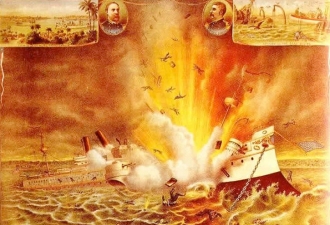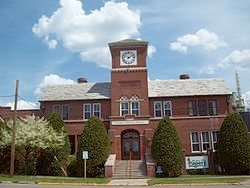Veterans’ Day, Nov. 11, was originally established as Armistice Day to honor the veterans of World War I. The armistice to end that war was signed on Nov. 11—the 11th hour of the 11th month of the 11th day.
But in 1954, President Dwight D. Eisenhower officially changed the holiday’s designation to Veterans’ Day as a way to honor all of the nation’s veterans from all of its wars.
Every year at the Little White School Museum here in Oswego, assistant museum director Bob Stekl and his crew of enthusiastic volunteers fills the museum’s main room with uniforms, photographs, and memorabilia of Oswego’s veterans, culled from the museum’s extensive collections. And every year, we seem to stumble across new facts and folks donate new veterans’ materials to the museum’s collections.

After the USS Maine exploded in the harbor at Havana, Cuba the night of Feb. 15, 1898, tensions between the U.S. and Spain grew until the U.S. declared war on April 25.
This year, we thought we’d delve into the Spanish-American War of 1898 a bit in order to highlight information concerning Philip Clauser, our community’s only veteran of what Theodore Roosevelt called “a splendid little war.” In gathering information and memorabilia about Clauser’s service, we also recalled that his son, Frank, went on to serve in World War II, where he was killed in action when his B-26 was shot down over the Mediterranean near Italy in 1943.
The story of Oswego’s Clauser military family really begins on the night of Feb. 15, 1898, as the USS Maine was riding easily at anchor in the harbor at Havana, Cuba when, at 9:40 p.m., an explosion ripped through the ship, which then sank, still at anchor, with the loss of 266 of her 355-man crew.
At the time, it was determined the ship was sunk by a mine. Subsequent investigations, however, suggest that an internal explosion cause the ship to sink. But whatever the cause, the disaster whipped the war fever that had been raging in the United States into a positive frenzy. When the U.S. demanded they vacate Cuba, Spain declined. On April 11, President William McKinley asked Congress for a declaration of war, and 12 days later he sent a request for 122,000 volunteers to the states.

Philip Clauser in a portrait taken about 1898 when he became the only person from Oswego to enlist to fight in the Spanish-American War. (Little White School Museum collection)
Then on April 25, 1898, Congress voted to declare war on Spain, a conflict that led to land and sea battles in both the Caribbean Sea and the eastern Pacific Ocean.
Among the volunteers flocking to the colors was Theodore Roosevelt himself, then Assistant Secretary of the Navy. Roosevelt resigned his office and eventually wangled command of the 1st U.S. Volunteer Cavalry Regiment—later famously nicknamed “The Rough Riders.”
Also volunteering was Oswegoan Philip Clauser, the only village resident who decided to serve.
Clauser was born in the heart of Pennsylvania Dutch country at Tower City, Schuylkill County, Pennsylvania on Aug. 12, 1868. As a young man, he decided to head west to Illinois where his aunt and uncle, John and Mary Ann (Wolf) Minnich, along with several cousins, were living in Oswego.
He worked at whatever jobs he could find, probably working for his cousins, Irvin Haines and Ed Inman, at carpentry in the spring, summer, and fall, and in the winter finding work with the Esch Brothers and Rabe Ice Company’s big ice harvesting and storage operation at Oswego. He also traveled for the company to their ice harvesting operations in Wisconsin, the Kendall County Record’s Oswego correspondent reporting on April 2, 1890: “Charles Rieger, Alf Wormley Lars Nelson, John Peterson and Phillip Clauser returned Saturday from Wisconsin where they were employed in the housing of ice for Esch Bros. & Rabe. The firm is said to have gathered a full supply.”
By the time the war with Spain was declared, the nation’s two biggest newspaper barons, Joseph Pulitzer and William Randolph Hearst, had used their media empires to whip up public enthusiasm for a war ostensibly fought to free the people of Cuba, Puerto Rico, and the Philippines from what Hearst and Pulitzer characterized as Spanish oppression. So when President McKinley issued his call for volunteers, there was no lack of men willing to go off to fight.
The President requested that Illinois supply seven regiments of infantry and one of cavalry.
Phil Clauser traveled up to Aurora on April 26, 1898, the day after Congress approved the declaration of war against Spain, to enlist in the Illinois National Guard’s 3rd Illinois Volunteer Infantry Regiment. He was assigned to Company I, under the command of Capt. Charles M. Greene, volunteering to serve for two years or until the end of the war, whichever came first. The regiment was commanded by Col. Fred Bennitt, a prominent Joliet lawyer who had risen to the rank of full colonel in the Illinois National Guard.
Company I traveled by train from Aurora to Springfield, where the entire regiment was mustered into U.S. service at Camp Tanner—actually the state fairgrounds, renamed for the duration of the war—on May 7. The regiment entrained once again for Camp George H. Thomas on the old battlefield at Chickamauga, Georgia, arriving May 16. The Georgia camp was fittingly named for one of the Union’s top Civil War generals who had been nicknamed “The Rock of Chickamauga” after he withstood rebel attacks during the battle in 1863.

A passenger liner, the USS St. Louis was armed after war with Spain was declared. The ship transported troops to Puerto Rico and went on to disrupt undersea communication cables between Spain and Cuba.
At Camp Thomas, the 3rd Illinois was fully equipped and underwent combat training. Three days after the regiment arrived, Phil Clauser was promoted to corporal.
Training complete, the troops left once again, this time for Newport News, Virginia, arriving July 24, where they were marched aboard the USS St. Louis and sailed for Puerto Rico, where they arrived off Ponce on July 31.
The Puerto Rican campaign was under the direct command of Gen. Nelson Miles, the U.S. Army’s commander-in-chief. The 3rd Illinois was assigned to Brig. Gen. Peter G. Hains’ Second Brigade along with the 4th Ohio and 4th Pennsylvania volunteer infantry regiments, plus a few other attached units. Miles ordered Hains to take Arroyo, a small port that served the larger nearby coastal town of Guayama. The brigade handily took Arroyo with only light resistance.
Then on Aug. 5, Haines ordered the 4th Ohio and the 3rd Illinois, supported by a battery of Sims-Dudley Dynamite guns to take Guayama itself. The Americans advanced up two small hills where Spanish forces had entrenched, and after a half-hour firefight the Illinoisans and Ohioans took the Spanish positions, suffering only three wounded.
Other than small skirmishes north of Guayama on Aug. 9 and 13, that was the 3rd Illinois’ last combat as they went into camp near the city. On Nov. 2, they filed aboard the SS Roumania and set sail for New York, arriving on Nov. 9. They were sent back to Illinois by train where they were granted furloughs before being mustered out of federal service on Jan. 24. Their “splendid little war” had lasted three months, three weeks, and two days.
Cpl. Clauser returned to Oswego, where he told folks he hadn’t minded his military adventure at all.
“Phil Clauser, the returned soldier from here, is one that enjoyed the war; says that they had both rough and good times, but on the while he liked the service, that if the thing was to be done over again he would not miss it,” the Record’s Oswego correspondent reported on Nov. 23, 1898.
Clauser married Ella Wolf and settled down in Oswego to raise a family that included two sons, Sylvester and Frank, who went on to fight in World War II. Phil Clauser remained proud of his service for the rest of his life and was an active member of the United Spanish War Veterans.
It’s likely he told his war stories to his sons as they grew up, so that when World War II broke out, they were more than willing to serve. Theodore, the oldest son, had been two young to serve in World War I, and then found himself too old to serve in World War II. But Sylvester and Frank were just right, Sylvester serving in the U.S. Navy, and Frank joining the U.S. Army Air Corps.
Frank Clauser was born in Oswego in 1911. He grew up among a tight group of friends and relatives—often they were one in the same. A good athlete, he played basketball and was a letter-winner on the undefeated 1929 Oswego High School football team. As a teenager, he was able to find work around Oswego, especially with his friend, Earl Zentmyer, who owned the local Ford auto dealership and garage.
After high school, Frank worked around Oswego and continued to live at home until he married his wife, Dorothy, and the couple moved to Aurora, where Frank found work building steel lockers and shelving at Durabilt Steel, one of the city’s many factories.

Sgt. Frank Clauser in a military portrait taken in 1942. (Little White School Museum collection)
When World War II broke out, he joined the Army and was assigned to the Army Air Corps.
After basic and advanced training, Frank was assigned to the newly activated 438th Bomb Squadron, part of the 319th Bomb Group. When the 438th received its B-26 Marauder aircraft, he became an engineer-gunner.
Designed and built by the Martin Aircraft Corporation, the B-26 was termed a medium bomber by the U.S. Army Air Corps. Its two Pratt and Whitney engines gave it good range (1,100 miles) and an excellent top speed (310 mph) while carrying a potent bomb load of 5,200 lbs. It was also heavily armed with 11 .50 cal. machine guns.
The men of the 319th Bomb Group trained with their B-26’s as low-level raiders, and then flew their aircraft to England in September of 1942. From there, they flew on to North Africa where they operated against Italian and German forces. Besides engaging in tactical bombing against ground targets, the B-26’s of the 319th Bomb Group were also used as interceptors to shoot down German transport aircraft flying from Italy carrying supplies to the Axis forces in North Africa.
After the German Afrika Korps and its Italian allies were defeated in North Africa, the 438th turned its attention towards Sicily and Italy. Flying at low altitudes, Sgt. Clauser and the rest of the men of the 438th Bomb Squadron used their low level bombing to hit ground targets in Sicily and Italy, and also attacked Axis shipping in the Mediterranean using skip bombing techniques.

One of the 319th Bomb Group’s B-26 Martin Marauders, this one from the 437th Bomb Squadron, identical to the aircraft in which Frank Clauser flew.
But as might be expected when flying a demanding aircraft at low levels during combat situations, losses were high. In fact, they were so high the bomb group temporarily stood down in February 1943 and retrained to bomb from medium levels. When Clauser’s outfit went back into action bombing rail marshaling yards from medium altitudes, aircraft losses dropped sharply.
The men of the 438th Bomb Squadron woke up on the morning of Aug. 22, 1943 anticipating another mission against Italy. Based at DJedeida, Algeria since late June, the 438th and the rest of the squadrons in the 319th Bomb Group were assigned to cut the supply lines of Axis forces in southern Italy in support of the upcoming Allied invasion of the European mainland–what Winston Churchill called “The Soft Underbelly of Europe.”
On this particular morning, the airmen learned they’d be bombing the railroad marshaling yards at Salerno, just down the coast from Naples. The crew of Clauser’s plane included the aircraft’s pilot, Lt. William Brown, co-pilot 2nd Lt. Richard Lobdell, and the navigator/bombardier 2nd Lt. Charles McVaughan, along with Staff Sgt. Alfred Conz, the radio operator and waist gunner and Staff Sgt. Sidney Gibbs. Sgt. Clauser was the plane’s gunner/engineer whose battle station was in the B-26’s dorsal turret armed with twin .50 cal. Browning machine guns.
After the crew strapped in, Lt. Brown lifted the plane off the airstrip for the hour’s flight to the Italian mainland. They never returned.
Later that month, the Clauser family was officially notified by telegram that Sgt. Clauser was missing in action. A terse note appeared in the Record’s “Oswego” column on Sept. 22, 1943: “Mr. and Mrs. Philip Clauser received the sad news that their youngest son, Frank, is missing in action. His wife lives in Aurora.”

The Clauser family received this note signed by the President after Frank Clauser was finally declared dead. Shot down over the Mediterranean off Salerno, Italy, his body was never recovered. (Little White School Museum collection)
Although the Army Air Corps listed him as missing, they knew he was almost certainly dead. Second Lt. Clarence Kozenski was piloting his B-26 just off Lt. Brown’s wing about ten minutes past noon on Aug. 22 when Axis fighters attacked the formation. He reported that Frank Clauser’s plane was riddled with bullets. One engine was set on fire, and large sections of the aircraft skin pealed off the vertical stabilizer at the tail before the aircraft plunged into the Mediterranean. Lt. Kozenski reported no parachutes were sighted as the plane crashed.
Although the family held out hope for his eventual return, it became more and more likely Frank would never come home as the months went by and no word was received. Eventually, his status as a casualty was verified and a gold star, denoting “Killed in Action,” was painted next to Sgt. Clauser’s name on the “Honor Roll” billboard in downtown Oswego that listed the men and women serving in the armed forces. His family received a Certificate of Honor from Oswego Township reading: “Certificate of Honor. To whom these presents shall come: Greetings: Whereas Frank Clauser, who as a member of the armed forces of this, our great and glorious country, gave his life for the cause of liberty and freedom he had always loved. These communities, with God’s Blessing, pay tribute to our beloved hero.” It was signed by Oswego Township Supervisor Oliver Burkhart, NaAuSay Township Supervisor Hugh Christian, and A.M. Pierce, Oswego village president.
Because his body was never found, Sgt. Clauser’s name is carved on The Wall of the Missing in the North Africa Cemetery along with the names of 3,723 other missing U.S. servicemen. The cemetery is located close to the ancient city of Carthage in Tunisia, near where Clauser and the rest of Lt. Brown’s crew left on their last flight. In addition to the honored missing, a total of 2,841 fallen U.S. servicemen are buried in neat ranks in the 27-acre cemetery.
This year’s “Remembering Our Veterans” exhibit will be held from Nov. 4 through 12 at the Little White School Museum, 72 Polk Street (Jackson at Polk) from 10 a.m. to 5 p.m. each day, and the two Clausers, father and son, will be among the hundreds honored for their service and, in Frank’s case, his ultimate sacrifice. You’re all invited, so stop on by; admission’s free.













